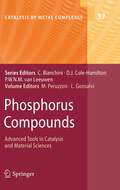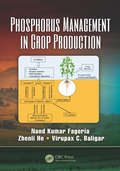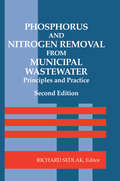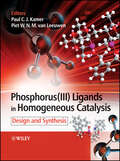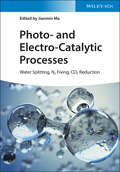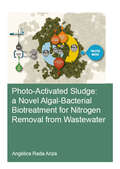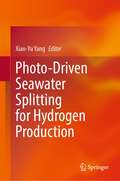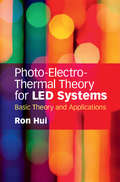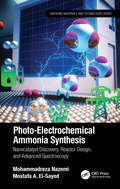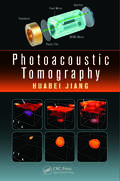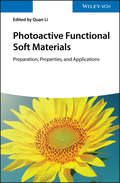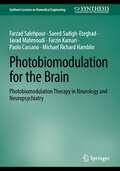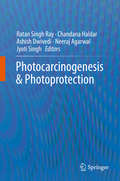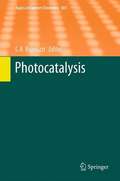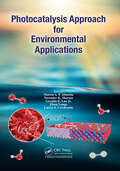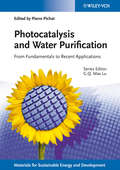- Table View
- List View
Phosphorus Compounds
by Luca Gonsalvi Maurizio PeruzziniEach chapter of Phosphorus Compounds: Advanced Tools in Catalysis and Material Sciences have been carefully selected by the editors in order to represent a state-of-the-art overview of how phosphorus chemistry can provide solutions in various fields of applications. The editors have assembled an international array of world-renowned scientists and each chapter is written by experts in the fields of synthetic chemistry, homogeneous catalysis, dendrimers, theoretical calculations, materials science, and medicinal chemistry with a special focus on the chemistry of phosphorus compounds. Phosphorus Compounds: Advanced Tools in Catalysis and Material Sciences is of interest to a general readership ranging from advanced university course students to experts in academia and industry.
Phosphorus Management in Crop Production
by Nand Kumar Fageria Zhenli He Virupax C. BaligarThe world population is projected to reach nine billion by 2050, and in the coming years, global food demand is expected to increase by 50% or more. Higher crop productivity gains in the future will have to be achieved in developing countries through better natural resources management and crop improvement. After nitrogen, phosphorus (P) has more widespread influence on both natural and agricultural ecosystems than any other essential plant element. It has been estimated that 5.7 billion hectares of land worldwide contain insufficient amounts of available P for sustainable crop production, and P deficiency in crop plants is a widespread problem in various parts of the world. However, it has been estimated that worldwide minable P could last less than 40 years. For sustaining future food supplies, it is vital to enhance plant P use efficiency. To bring the latest knowledge and research advances in efficient management of P for economically viable and environmentally beneficial crop production in sustainable agriculture, Phosphorus Management in Crop Production contains chapters covering functions and diagnostic techniques for P requirements in crop plants, P use efficiency and interactions with other nutrients in crop plants, management of P for optimal crop production and environmental quality, and basic principles and methodology regarding P nutrition in crop plants. The majority of research data included are derived from many years of field, greenhouse, and lab work, hence the information is practical in nature and will have a significant impact on efficient management of P-fertilizers to enhance P use efficiency, improve crop production, promote sustainable agriculture, and reduce P losses through eluviations, leaching, and erosion to minimize environmental degradation. A comprehensive book that combines practical and applied information, Phosphorus Management in Crop Production is an excellent reference for students, professors, agricultural research scientists, food scientists, agricultural extension specialists, private consultants, fertilizer companies, and government agencies that deal with agricultural and environmental issues.
Phosphorus Recovery and Recycling
by Hisao Ohtake Satoshi TsunedaThis book focuses on the engineering aspects of phosphorus (P) recovery and recycling, presenting recent research advances and applications of technologies in this important and challenging area of engineering. It highlights full-scale applications to illustrate the performance and effectiveness of the new technologies. As an essential element for all living organisms, P cannot be replaced by any other element in biochemical processes, humans ultimately rely its availability. Today, P is mostly obtained from mined rock phosphate (Pi). However, natural reserves of high-grade rock Pi are limited and dwindling on a global scale. As such, there have been increased efforts to recycle P from secondary sources, including sewage sludge, animal manure, food waste, and steelmaking slag, and so close the anthropogenic P cycle. In addition to various aspects of phosphorus covered by other literature, including chemistry, biochemistry, ecology, soil-plant systems and sustainable management, this book is a valuable and comprehensive source of information on the rapidly evolving field of P recovery and recycling engineering for students, researchers, and professionals responsible for sustainable use of phosphorus.
Phosphorus and Nitrogen Removal from Municipal Wastewater: Principles and Practice, Second Edition
by RichardI. SedlakThis valuable new book offers practical guidance regarding the design and operation of systems for reducing effluent nitrogen and phosphorus. The principles of nitrogen and phosphorus removal are discussed, including sources of nitrogen and phosphorus in wastewater, removal options, nitrogen and phosphorus transformations in treatment, process selection, and treatment. The book also covers the design and operation of nitrogen and phosphorus removal systems, including system options, system design, facility design, facility costs, and operation. Practical case studies are provided as examples of successful system implementations that may be able to help you decide what will work best in your plant.
Phosphorus in Action
by Astrid Oberson Else K. Bünemann Emmanuel FrossardPhosphorus (P) is a finite resource which is essential for life. It is a limiting nutrient in many ecosystems but also a pollutant which can affect biodiversity in terrestrial ecosystems and change the ecology of water bodies. This book collects the latest information on biological processes in soil P cycling, which to date have remained much less understood than physico-chemical processes. The methods section presents spectroscopic techniques and the characterization of microbial P forms, as well as the use of tracers, molecular approaches and modeling of soil-plant systems. The section on processes deals with mycorrhizal symbioses, microbial P solubilization, soil macrofauna, phosphatase enzymes and rhizosphere processes. On the system level, P cycling is examined for grasslands, arctic and alpine soils, forest plantations, tropical forests, and dryland regions. Further, P management with respect to animal production and cropping, and the interactions between global change and P cycling, are treated.
Phosphorus(III)Ligands in Homogeneous Catalysis
by Paul C. Kamer Piet W.N.M. van LeeuwenOver the last 60 years the increasing knowledge of transition metal chemistry has resulted in an enormous advance of homogeneous catalysis as an essential tool in both academic and industrial fields. Remarkably, phosphorus(III) donor ligands have played an important role in several of the acknowledged catalytic reactions. The positive effects of phosphine ligands in transition metal homogeneous catalysis have contributed largely to the evolution of the field into an indispensable tool in organic synthesis and the industrial production of chemicals.This book aims to address the design and synthesis of a comprehensive compilation of P(III) ligands for homogeneous catalysis. It not only focuses on the well-known traditional ligands that have been explored by catalysis researchers, but also includes promising ligand types that have traditionally been ignored mainly because of their challenging synthesis.Topics covered include ligand effects in homogeneous catalysis and rational catalyst design, P-stereogenic ligands, calixarenes, supramolecular approaches, solid phase synthesis, biological approaches, and solubility and separation.Ligand families covered in this book include phosphine, diphosphine, phosphite, diphosphite, phosphoramidite, phosphonite, phosphinite, phosphole, phosphinine, phosphinidenene, phosphaalkenes, phosphaalkynes, P-chiral ligands, and cage ligands.Each ligand class is accompanied by detailed and reliable synthetic procedures. Often the rate limiting step in the application of ligands in catalysis is the synthesis of the ligands themselves, which can often be very challenging and time consuming. This book will provide helpful advice as to the accessibility of ligands as well as their synthesis, thereby allowing researchers to make a more informed choice.Phosphorus(III) Ligands in Homogeneous Catalysis: Design and Synthesis is an essential overview of this important class of catalysts for academic and industrial researchers working in catalyst development, organometallic and synthetic chemistry.
Phosphorus: Chemistry, Biochemistry and Technology, Sixth Edition
by D.E.C. CorbridgeOver two decades have passed since the fifth edition of Phosphorus: Chemistry, Biochemistry and Technology. Major advances in chemistry, materials science, electronics, and medicine have expanded and clarified the role of phosphorus in both our everyday appliances and groundbreaking research. Significantly expanded, updated, and reorganized, this s
Photo- and Electro-Catalytic Processes: Water Splitting, N2 Fixing, CO2 Reduction
by Jianmin MaExplore green catalytic reactions with this reference from a renowned leader in the field Green reactions—like photo-, photoelectro-, and electro-catalytic reactions—offer viable technologies to solve difficult problems without significant damage to the environment. In particular, some gas-involved reactions are especially useful in the creation of liquid fuels and cost-effective products. In Photo- and Electro-Catalytic Processes: Water Splitting, N2 Fixing, CO2 Reduction, award-winning researcher Jianmin Ma delivers a comprehensive overview of photo-, electro-, and photoelectron-catalysts in a variety of processes, including O2 reduction, CO2 reduction, N2 reduction, H2 production, water oxidation, oxygen evolution, and hydrogen evolution. The book offers detailed information on the underlying mechanisms, costs, and synthetic methods of catalysts. Filled with authoritative and critical information on green catalytic processes that promise to answer many of our most pressing energy and environmental questions, this book also includes: Thorough introductions to electrocatalytic oxygen reduction and evolution reactions, as well as electrocatalytic hydrogen evolution reactions Comprehensive explorations of electrocatalytic water splitting, CO2 reduction, and N2 reduction Practical discussions of photoelectrocatalytic H2 production, water splitting, and CO2 reduction In-depth examinations of photoelectrochemical oxygen evolution and nitrogen reductionPerfect for catalytic chemists and photochemists, Photo- and Electro-Catalytic Processes: Water Splitting, N2 Fixing, CO2 Reduction also belongs in the libraries of materials scientists and inorganic chemists seeking a one-stop resource on the novel aspects of photo-, electro-, and photoelectro-catalytic reactions.
Photo-Activated Sludge: A Novel Algal-Bacterial Biotreatment for Nitrogen Removal from Wastewater (IHE Delft PhD Thesis Series)
by Angélica Rada ArizaNitrogen rich wastewaters (10-400 mg N L-1) are usually produced by municipal, industrial and agricultural wastes, such as effluents from anaerobic treatments. These represent a risk to the environment due to the high nutrient concentrations (nitrogen and phosphorous), which can cause eutrophication of water bodies, deteriorating the quality of the ecosystems. As a solution, the potential nitrogen removal capacity of a novel bio-treatment system, namely the Photo-Activated Sludge (PAS), which is composed of microalgae and bacteria consortia, is presented in this thesis. <P><P>This novel bio-treatment is based on the symbiosis between microalgae, nitrifiers and heterotrophic bacteria (microalgal-bacterial consortia). Experimental work using photobioreactors for the cultivation of microalgae and bacteria under sequencing batch conditions showed that microalgal-bacterial consortia can remove ammonium 50% faster than solely microalgal consortia. The increase in ammonium removal rates was due to the action of nitrifying bacteria, supplied with oxygen produced by algae. Nitrification was the main ammonium removal mechanism within the microalgal-bacterial biomass, followed by algal uptake and nutrient requirements for bacterial growth. Carbon oxidation and denitrification were the main removal mechanisms for organic carbon. Hence, the role of algae within the microalgal-bacterial system is to provide oxygen to support the aerobic processes. The microalgal-bacterial system offers the possibility of reducing the hydraulic retention time, which can decrease the large area requirements often demanded by algal systems.
Photo-Driven Seawater Splitting for Hydrogen Production
by Xiao-Yu YangThis book presents photo-driven seawater splitting technologies for hydrogen production. This technology is considered as a win–win interplay for both the utilization of solar energy as the most renewable energy and seawater as the most hydrogen source. The book also discusses topics from raw materials selection, characterization and mechanistic insights to the latest research developments in response to the need for environmentally friendly and low-carbon industries. In addition, it provides insights into a most attractive energy-conversion and storage cascade by combining solar energy and a hydrogen system. Given its scope, this book appeals to a broad readership, particularly professionals at universities and scientific research institutes, as well as practitioners in industry.
Photo-Electro-Thermal Theory for LED Systems: Basic Theory and Applications
by Ron HuiGain a solid understanding of Light-Emitting Diode (LED) Systems Theory with this unique book. Written by a leading expert in LED lighting, it links together the photometric, electrical, thermal and chromatic elements of LED systems into a single, unified framework, and explores their complex interactions with one another. * Get to grips with chromatic, photometric and thermal modelling of LED systems * Discover new techniques for precise dimming and colour control * Learn methods for determining system parameters and internal variables * Gain insight into advanced applications for LED system design and optimization Providing straightforward and intuitive explanations, this is an ideal guide for professional engineers, graduate students and researchers working on solid-state lighting systems and smart lighting, and those taking advanced courses on LED devices and systems.
Photo-Electrochemical Ammonia Synthesis: Nanocatalyst Discovery, Reactor Design, and Advanced Spectroscopy (Emerging Materials and Technologies)
by Mohammadreza Nazemi Mostafa A. El-SayedAmmonia holds great promise as a carbon-neutral liquid fuel for storing intermittent renewable energy sources and power generation due to its high energy density and hydrogen content. Photo-Electrochemical Ammonia Synthesis: Nanocatalyst Discovery, Reactor Design, and Advanced Spectroscopy covers the synthesis of novel hybrid plasmonic nanomaterials and their application in photo-electrochemical systems to convert low energy molecules to high value-added molecules and looks specifically at photo-electrochemical nitrogen reduction reaction (NRR) for ammonia synthesis as an attractive alternative to the long-lasting thermochemical process. Provides an integrated scientific framework, combining materials chemistry, photo-electrochemistry, and spectroscopy to overcome the challenges associated with renewable energy storage and transport Reviews materials chemistry for the synthesis of a range of heterogeneous (photo) electrocatalysts including plasmonic and hybrid plasmonic-semiconductor nanostructures for selective and efficient conversion of N2 to NH3 Covers novel reactor design to study the redox processes in the photo-electrochemical energy conversion system and to benchmark nanocatalysts’ selectivity and activity toward NRR Discusses the use of advanced spectroscopic techniques to probe the reaction mechanism for ammonia synthesis Offers techno-economic analysis and presents performance targets for the scale-up and commercialization of electrochemical ammonia synthesis This book is of value to researchers, advanced students, and industry professionals working in sustainable energy storage and conversion across the disciplines of Chemical Engineering, Mechanical Engineering, Materials Science and Engineering, Environmental Engineering, and related areas.
Photo-Excited Charge Collection Spectroscopy
by Seongil Im Youn-Gyoung Chang Jae Hoon KimSolid state field-effect devices such as organic and inorganic-channel thin-film transistors (TFTs) have been expected to promote advances in display and sensor electronics. The operational stabilities of such TFTs are thus important, strongly depending on the nature and density of charge traps present at the channel/dielectric interface or in the thin-film channel itself. This book contains how to characterize these traps, starting from the device physics of field-effect transistor (FET). Unlike conventional analysis techniques which are away from well-resolving spectral results, newly-introduced photo-excited charge-collection spectroscopy (PECCS) utilizes the photo-induced threshold voltage response from any type of working transistor devices with organic-, inorganic-, and even nano-channels, directly probing on the traps. So, our technique PECCS has been discussed through more than ten refereed-journal papers in the fields of device electronics, applied physics, applied chemistry, nano-devices and materials science, finally finding a need to be summarized with several chapters in a short book. Device physics and instrumentations of PECCS are well addressed respectively, in the first and second chapters, for the next chapters addressing real applications to organic, oxide, and nanostructured FETs. This book would provide benefits since its contents are not only educational and basic principle-supportive but also applicable and in-house operational.
Photo-switched Biodegradation of Bioplastics in Marine Environments
by Tatsuo KanekoThis book presents the novel concept of photo-switched biodegradation of bioplastics which is one of the important methods to overcome plastic waste issues in oceans. The different chapters discuss topics associated with a wide range of biorefinery plant cultivation, cell bioengineering in silico/wet, plastic design with photo-controlled biodegradation, photocatalysis design, evaluation of biodegradability, polymer toxicity, and plastic edibility. The book contributes to various Sustainable Development Goals such as SDG 14—Life Below Water; SDG 9—Industry, Innovation and Infrastructure; SDG 12—Responsible Consumption and Production; and SDG 15—Life on Land. It is a useful source for academic scientists in the fields of organic chemistry, photocatalysts, organic/inorganic composites, cell biology, plant biology, plastic processing, social control of wastes, environmental science, marine technology, and engineers. The book plays a big part in paradigm-changing innovation and transforms the petrochemical industry which has reached maturity, into a biochemical industry.
Photoacoustic Tomography
by Huabei JiangThe concept of photoacoustic tomography (PAT) emerged in the mid-1990s, and the field of PAT is now rapidly moving forward. Presenting the research of a well-respected pioneer and leading expert, Photoacoustic Tomography is a first-of-its-kind book covering the underlying principles and practical applications of PAT in a systematic manner. Written in a tutorial format, the text: Addresses the fundamentals of PAT, the theory on photoacoustic effect, image reconstruction methods, and instrumentation Details advanced methods for quantitative PAT, which allow the recovery of tissue optical absorption coefficient and/or acoustic properties Explores the development of several image-enhancing schemes, including both software and hardware approaches Examines array-based PAT systems that are the foundation for the realization of 2-D, 3-D, and 4-D PAT Discusses photoacoustic microscopy (PAM) and combinations of PAT/PAM with other imaging methods Considers contrast-agents-based molecular PAT, with both nontargeted and cell receptor–targeted methods Describes clinical applications and animal studies in breast cancer detection, osteoarthritis diagnosis, seizure localization, intravascular imaging, and image-guided cancer therapy Photoacoustic Tomography is an essential reference for graduate students, researchers, industry professionals, and those who wish to enter this exciting field.
Photoactive Functional Soft Materials: Preparation, Properties, and Applications
by Quan LiThe book covers design, synthesis, properties and applications of functional photoactive soft materials, including aspects of polymers, block copolymers, elastomers, biomaterials, liquid crystals, chemical and physical gels, colloids, host-guest systems and foams. Authoritative accounts describing various structural and functional aspects of photoactive soft materials are combined in a unified manner in this book. The main focus is on the design and fabrication of photoactive functional soft materials for materials science, nanophotonics, nanotechnology, biological, biomedical and pharmacological applications.
Photobiomodulation for the Brain: Photobiomodulation Therapy in Neurology and Neuropsychiatry (Synthesis Lectures on Biomedical Engineering)
by Farzad Salehpour Saeed Sadigh-Eteghad Javad Mahmoudi Farzin Kamari Paolo Cassano Michael Richard HamblinPhotobiomodulation for the Brain: Photobiomodulation Therapy in Neurology and Neuropsychiatry collects scientific evidence covering a broad range of topics, including the optimum dosimetry, treatment regimens, irradiation sites, irradiance and fluence, treatment times, and possible side effects of this neuromodulation therapy. Over the past two decades, brain photobiomodulation (PBM) therapy has been introduced as an innovative modality for stimulating neural activity to improve brain function and is predicted to become a promising strategy for neurorehabilitation in the coming years. This book introduces PBM therapy to the worldwide medical community, providing worthwhile scientific insights and promoting the acceptance of this field among neurologists, psychiatrists, neurorehabilitation practitioners, and physiotherapists, as well as neuroscience clinicians and researchers. From a physics point of view, scientists in the photonics, medical physics, and light-dosimetry fields will also benefit from the book.
Photocarcinogenesis & Photoprotection
by Jyoti Singh Ratan Singh Ray Chandana Haldar Ashish Dwivedi Neeraj AgarwalThis book highlights the problem of UV-R-induced photocarcinogenesis and its molecular mechanism. It covers different photosensitive xenobiotics (drugs, cosmetics, and environmental pollutants) and their photosensitization mechanisms under ambient UV-R exposure. It also summarizes the role of nanotechnology in skin cancer remedies. It provides a brief overview of the various novel nanocarriers for cosmeceuticals like nanoemulsions, liposomes, solid lipid nanoparticles (SLNs), dendrimers, inorganic nanoparticles, nanocrystals, etc., nanotechnology-based cosmeceutical products which are available in the market. It highlights the possible health hazards caused by nanoparticles on exposure of nano-based cosmetics and describes the recent regulatory rules applied to avoid the nanotoxicity.
Photocatalysis
by Carlo Alberto BignozziMetal Oxide Photoanodes for Water Splitting, by J. Augustynski, B. D. Alexander and R. Solarska; Hydrogen Production with Nanostructured and Sensitized Metal Oxides , by Stefano Caramori, Vito Cristino, Laura Meda, Roberto Argazzi and Carlo Alberto Bignozzi; Surface Nanostructures in Photocatalysts for Visible-Light-Driven Water Splitting, by Kazuhiko Maeda and Kazunari Domen; Artificial Photosynthesis Challenges: Water Oxidation at Nanostructured Interfaces, by Mauro Carraro, Andrea Sartorel, Francesca Maria Toma, Fausto Puntoriero, Franco Scandola, Sebastiano Campagna, Maurizio Prato and Marcella Bonchio; Photocatalytic Reduction of CO2: From Molecules to Semiconductors, by Tatsuto Yui, Yusuke Tamaki, Keita Sekizawa and Osamu Ishitani; Design of Heterogeneous Photocatalysts Based on Metal Oxides to Control the Selectivity of Chemical Reactions, by Andrea Maldotti and Alessandra Molinari;
Photocatalysis Approach for Environmental Applications
by Elson Longo Surender K. Sharma Marcio A. P. Almeida Geraldo E. Luz Laécio S. CavalcanteCurrently, many of the technological advances around the world are limited by the lack of understanding about materials science and its applications. Beginning researchers in materials sciences worldwide have had great difficulty developing their research. This book is aimed at undergraduate students and researchers in materials sciences. It aims to provide a greater understanding of the potential of semiconductor materials for environmental applications such as renewable energy, energy storage systems, and remediation of degraded environments.
Photocatalysis and Water Purification
by Max Lu Pierre PichatWater is one of the essential resources on our planet. Therefore, fresh water and the recycling of waste-water are very important topics in various areas. Energy-saving green technologies are a demand in this area of research.Photocatalysis comprises a class of reactions which use a catalyst activated by light. These reactions include the decomposition of organic compounds into environmental friendly water and carbon dioxide, leading to interesting properties of surfaces covered with a photocatalyst:they protect e.g. against incrustation of fouling matter, they are self-cleaning, antibacterial and viricidal. Therefore, they are attractive candidates for environmental applications such as water purification and waste-water treatment.This book introduces scientists and engineers to the fundamentals of photocatalysis and enlightens the potentials of photocatalysis to increase water quality. Also, strategies to improve the photocatalytic efficacy are pointed out: synthesis of better photocatalysts, combination ofphotocatalysis with other technologies, and the proper design of photocatalytic reactors. Implementation of applications and a chapter on design approaches for photocatalytic reactors round off the book.'Photocatalysis and Water Purification' is part of the series on Materials for Sustainable Energy and Development edited by Prof. G.Q. Max Lu. The series covers advances in materials science and innovation for renewable energy, clean use of fossil energy, and greenhouse gas mitigation and associated environmental technologies.
Photocatalysis for Energy and Environmental Applications: Current Trends and Future Perspectives (Green Energy and Technology)
by Panneerselvam SathishkumarThis book presents the existing photocatalytic reactor design and the future developments and the progress needed for both solar light-driven hydrogen generation and environmental purification. The chapters discuss the renewable and commercial aspects of translucent polymer-linked heterojunction nanocomposites as visible light-responsive photocatalysts. Relevant to these areas, the field of growing interest in black-TiO2, perovskites, MXenes and their numerous applications are presented. The framework, structural features and the need of mesocrystals for solar light-driven photocatalysis are also included. The book also discusses the additional features of green chemistry-based synthesis of nanomaterials in order to reduce any secondary pollution that may be released in the environment due to unsafe disposal of solvents. In addition, the importance of bismuth-based nanophotocatalysts towards energy and environmental applications and their future development as alternative photocatalysts for the prevailing nanomaterials are presented. The book also touches upon the idea to generate green fuel hydrogen through photocatalytic and photoelectrochemical techniques. Overall the book highlights contemporary developments in the last decade, the future perspectives of photocatalysis and its application towards energy and environment.
Photocatalysis for Environmental Remediation and Energy Production: Recent Advances and Applications (Green Chemistry and Sustainable Technology)
by Seema Garg Amrish ChandraThis book explores the modification of various synthesis processes to enhance the photocatalytic activity in varied applications in the fields of environmental remediation and energy production. It outlines the enhancement of photocatalytic activity via alloys synthesis, thin film coatings, electro-spun nanofibers and 3D printed photocatalysts. The book further states the diverse applications of materials for degrading organic pollutants and airborne pathogens, improving indoor air quality and as a potential antimicrobial agent. The application of photocatalysts in green organic synthesis, biomedical field and in hydrogen evolution are also presented in the book. It covers theoretical studies of photocatalytic material and conversion of CO2 to value added chemical feed stocks. The book is of relevance to researchers in academia and industry alike in the fields of material science, environmental science & technology, photocatalytic applications and in energy generation and conversion.
Photocatalysis for Heterocycle Formation and Functionalisation (Topics in Heterocyclic Chemistry #62)
by Wen-Jing XiaoHeterocyclic compounds are an important class of organic chemicals that feature one or more heteroatoms in their ring systems. Such compound class have played an important role in our daily lives, as they are ubiquitous in natural products, pharmaceuticals, and other biologically active molecules. Many heterocyclic scaffolds have been identified as privileged structural units in pharmacologically active compounds. According to statistics, more than 90% of novel pharmaceuticals contain at least one heterocycle. Advances in modern synthetic techniques, such as organocatalytic cycloadditions, metal-catalyzed cross-coupling reactions, have offered many efficient and rapid approaches for assembly of diverse heterocycles of various ring sizes. However, given increasing need for expansion of the available drug-like chemical space and from both environmental and economical viewpoints, it is still highly desirable to develop new efficient and practical methodologies toward heterocycle synthesis and functionalization under “green and sustainable” conditions. Photocatalysis is emerging as a powerful tool to access diverse high-energy intermediates in a controlled and selective fashion, and capable of promoting numerous challenging bond formation and novel chemical transformation. This re-merging catalytic strategy fits with green chemistry principles and has significantly spurred many innovative approaches that use of low energy photons as a controllable energy source to enable heterocycle formation and functionalization under mild conditions. In this book, we have tried to cover some interesting aspects of the development of photocatalytic reactions that are aimed to construct diverse heterocyclic compounds. Specifically, this major content is devoted to the following research topics, including N-heterocycle formation (Chapters 1, 4, and 6), functionalization of N-heterocycles (Chapters 2, 3, and 8), chiral heterocycle formation (Chapter 5), dearomatization of heterocycles (Chapter 7), fused thiophene formation and functionalization (Chapter 9), construction of axially chiral heterocyclies (Chapter 10), and photoinduced biocatalytic heterocycle formation (Chapter 11). It is our hope that this book, in addition to being of interest to practitioners of medicinal chemistry and organic synthesis who need an introduction to this area, will also be found inspiriting and stimulating by undergraduate and graduate students.
Photocatalysis: Principles and Applications
by Suresh C. Ameta Rakshit AmetaPhotocatalysis, reactions carried out in the presence of a semiconductor and light, is rapidly becoming one of the most active areas of chemical research, with applications in areas such as electrochemistry, medicine, and environmental chemistry, Photocatalysis: Principles and Applications stresses the development of various types of photocatalytic semiconductors, including binary, ternary, quaternary, and composite, and their modifications by metallization, sensitization, and doping to enhance their photocatalytic activities. In addition to describing the principles and mechanisms of photocatalysis, it also discusses other possible applications of photocatalysis such as use as antifouling agents, controlling air pollution by degrading contaminants present in the environment, self-cleaning of glasses and tiles in the presence of light/artificial light, green composites, wastewater treatment, hydrogen generation, and inactivation of microorganisms. The book also describes medical applications and summarizes efforts in the field of photosplitting of water as a newer energy source and photoreduction of carbon dioxide for providing synthetic fuels and also a step towards mimicking photosynthesis. Introduces the basic principle of photocatalysis. Provides an overview of the types of semiconductors, their immobilization, and modifications to make them more active. Gives possible applications of photocatalysis in wastewater treatment and strategy to combat against different kinds of pollutions like water, air, and soil. Summarizes efforts in the field of photosplitting of water as a newer energy source and photoreduction of carbon dioxide for providing synthetic fuels and as a step towards mimicking photosynthesis. Discusses inactivation of different kinds of microorganisms. Covers medical applications. Features Introduces the basic principle of photocatalysis. Provides an overview of the types of semiconductors, their immobilization, and modifications to make them more active. Gives possible applications of photocatalysis in wastewater treatment and strategy to combat against different kinds of pollutions like water, air, and soil. Summarizes efforts in the field of photosplitting of water as a newer energy source and photoreduction of carbon dioxide for providing synthetic fuels and as a step towards mimicking photosynthesis. Discusses inactivation of different kinds of microorganisms. Covers medical applications.
